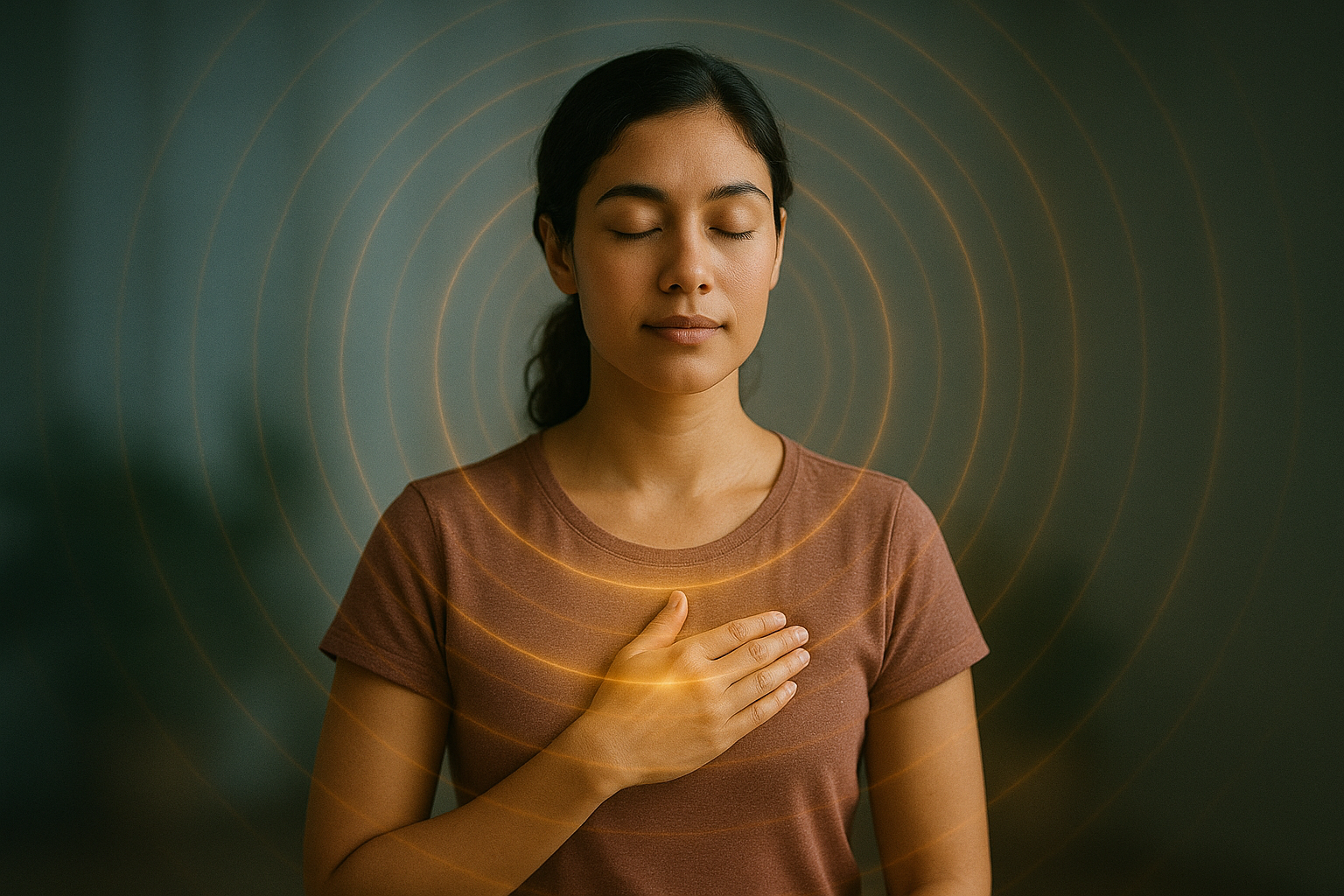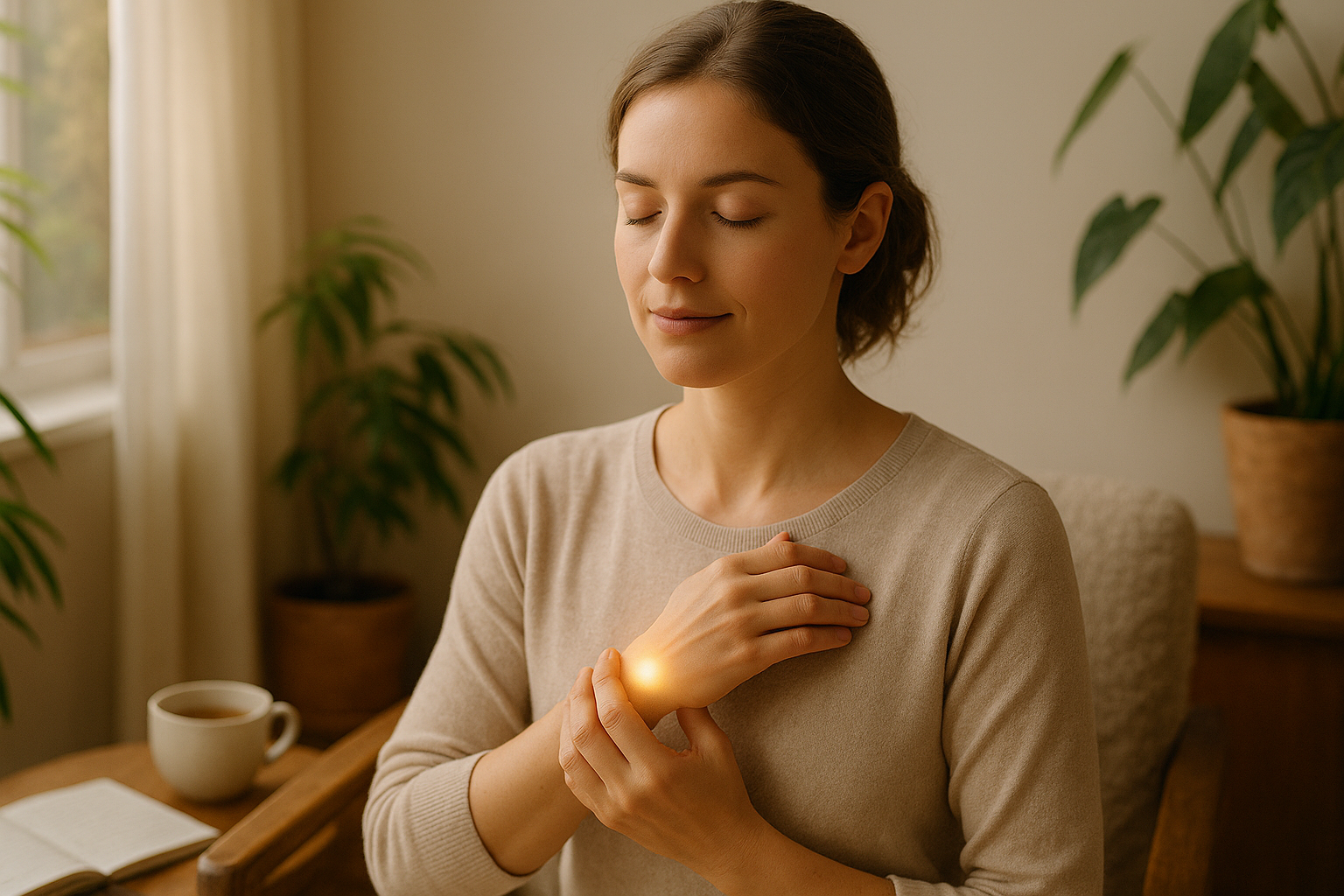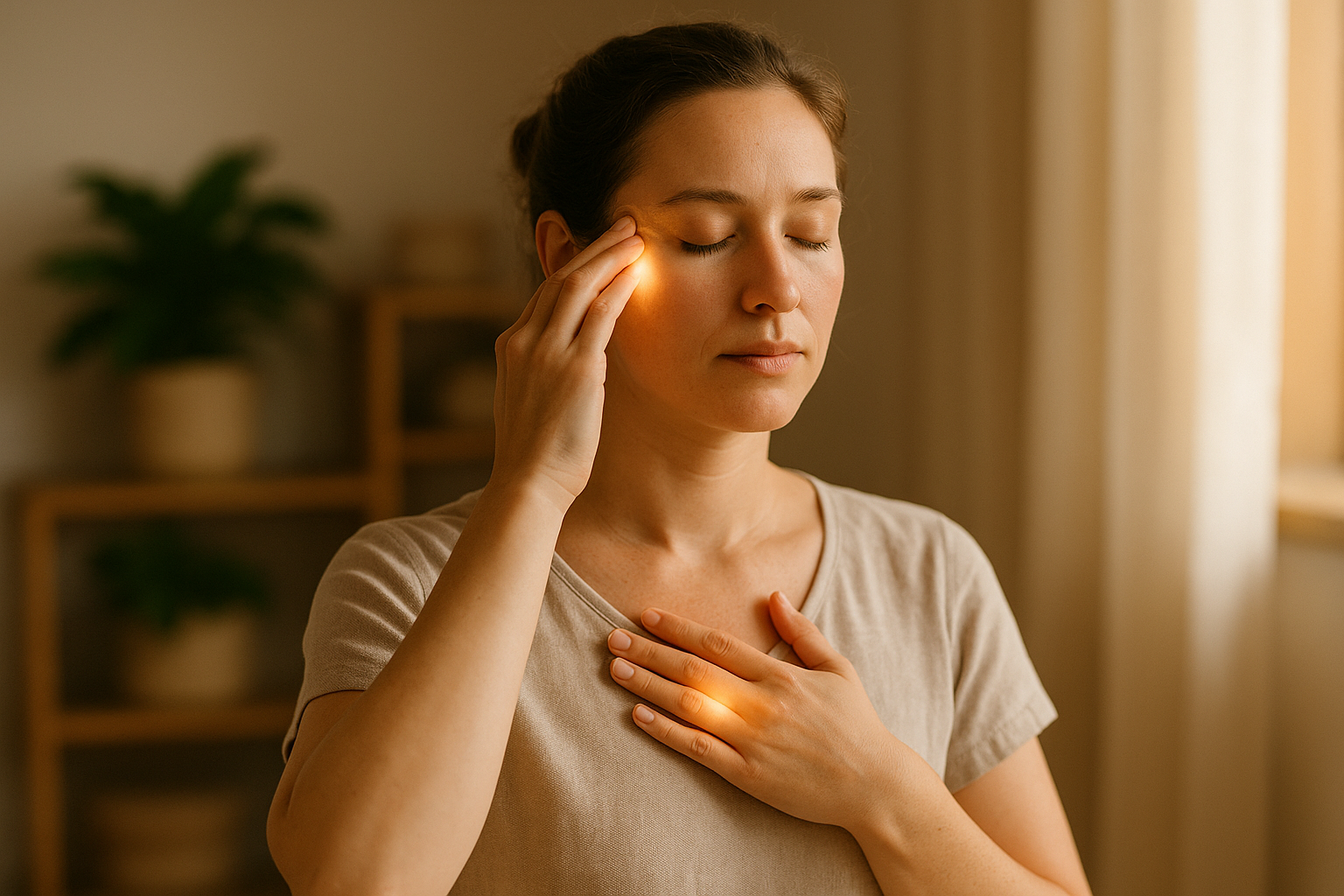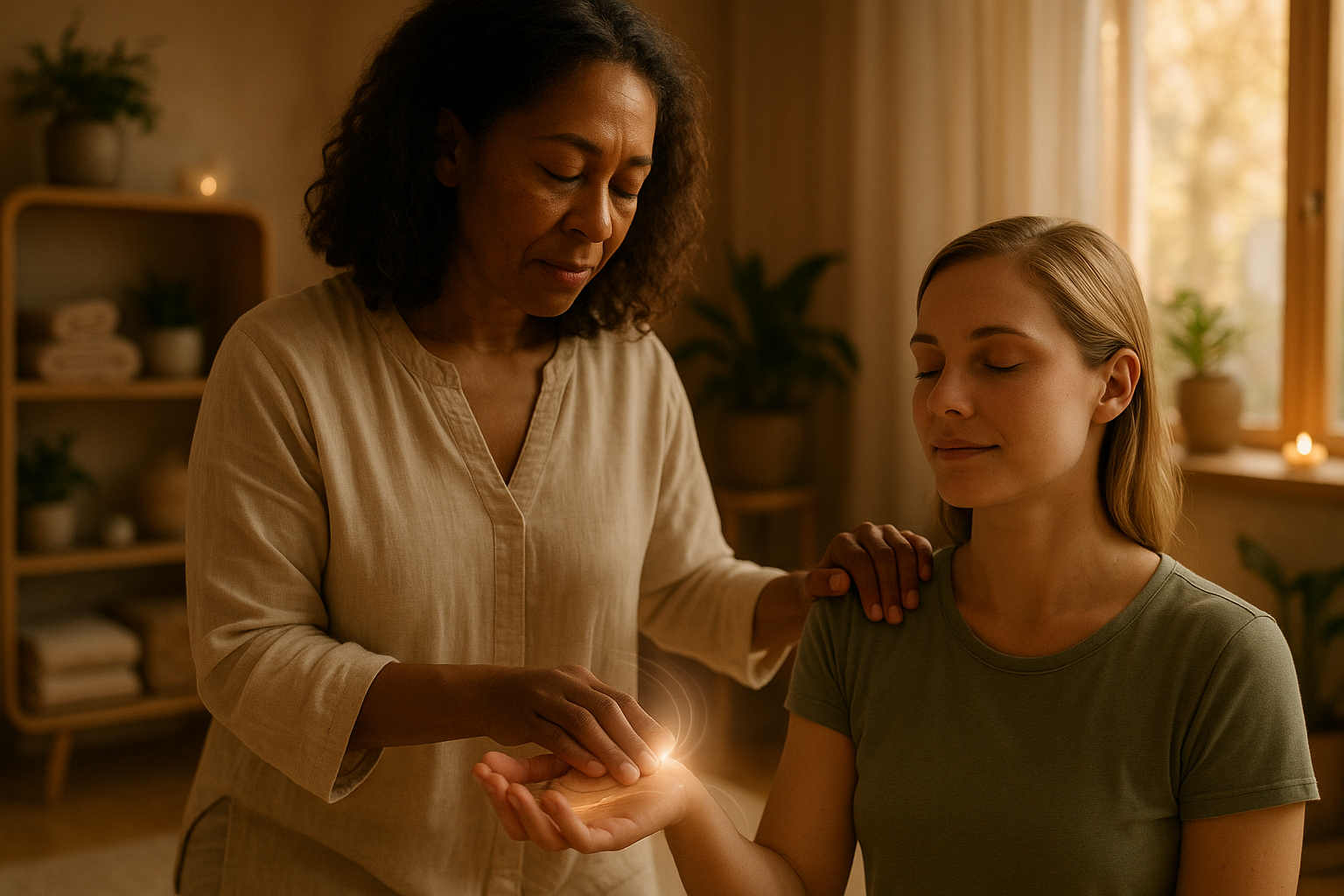Estimated Reading Time: 10–12 minutes
What You Will Learn
-
The science and philosophy behind acupressure as a tool for emotional healing
-
How the hands connect to your body’s energy systems and emotional states
-
Simple, practical acupressure points for stress, anxiety, and emotional release
-
Step-by-step guidance for daily practice
-
How to integrate touch and mindfulness for long-term emotional balance
The Ancient Wisdom in Your Hands
 Touch has always been humanity’s first language of healing. Long before modern medicine, people instinctively placed their hands over areas of pain, tension, or grief. Ancient healing systems — from Traditional Chinese Medicine (TCM) to Ayurveda — recognized this instinct not as mere comfort, but as a form of intelligent communication between body and mind.
Touch has always been humanity’s first language of healing. Long before modern medicine, people instinctively placed their hands over areas of pain, tension, or grief. Ancient healing systems — from Traditional Chinese Medicine (TCM) to Ayurveda — recognized this instinct not as mere comfort, but as a form of intelligent communication between body and mind.
Acupressure, a practice that dates back over 5,000 years in China, is based on the principle that energy — or qi (pronounced “chee”) — flows through the body along invisible channels known as meridians. When energy becomes blocked, physical or emotional imbalances arise. By pressing on specific points along these pathways, acupressure helps restore flow, balance, and harmony.
Today, this ancient wisdom meets modern science. Research shows that gentle pressure on specific points can activate the parasympathetic nervous system — your body’s natural “rest and digest” mode — helping to lower stress hormones, regulate emotions, and improve overall well-being (Lee et al., 2015; Kurebayashi et al., 2012).
Your hands, it turns out, are already equipped with everything you need to begin.
The Connection Between Hands and Emotions
In Traditional Chinese Medicine, the hands are considered extensions of the heart. Each finger and palm region corresponds to a meridian and, by extension, an emotion or organ system.
For example:
-
The thumb connects to the lung meridian, associated with grief and letting go.
-
The index finger corresponds to the large intestine meridian, linked with release and courage.
-
The middle finger relates to the pericardium meridian, the protector of the heart.
-
The ring finger connects to the triple warmer, influencing harmony and balance.
-
The little finger is tied to the heart meridian, symbolizing joy and connection.
When emotions overwhelm us — sadness, anger, anxiety, or fear — energy can stagnate along these meridians. Gentle self-touch through acupressure allows us to move that energy again, supporting both physiological regulation and emotional clarity.
In essence, your hands not only feel your emotions — they can heal them.
How Acupressure Works on the Nervous System
From a scientific perspective, acupressure influences the body through multiple pathways:
-
Neurochemical Regulation: Stimulating acupoints increases endorphin and serotonin levels, reducing pain and anxiety (Agarwal et al., 2005).
-
Vagal Activation: Gentle touch activates the vagus nerve, which calms the heart rate, deepens breathing, and promotes relaxation (Porges, 2011).
-
Mind-Body Awareness: The act of touch brings attention back to the present moment, bridging mindfulness and somatic awareness — key elements in emotional healing.
In short, acupressure isn’t magic — it’s biology, mindfulness, and compassion working together.
Preparing for Practice: Setting the Space and Intention
Before you begin, approach acupressure as a form of self-communication, not control. This is not about fixing yourself but listening deeply.
-
Find a quiet space. Dim lights, silence notifications, and settle into stillness.
-
Warm your hands. Rub them together gently until they feel warm. This not only increases blood flow but also prepares your awareness for touch.
-
Set an intention. Ask yourself: What do I need right now? Calm? Clarity? Release?
-
Breathe. Inhale slowly through the nose, exhale through the mouth. Let your breath guide the rhythm of your touch.
Practice 1: The Heart Calming Point (HT7 – Shenmen)
 Location: On the wrist crease, just below the pinky finger.
Location: On the wrist crease, just below the pinky finger.
Benefits: Reduces anxiety, emotional overwhelm, and restlessness.
How to apply:
-
Using the thumb of your opposite hand, locate the small hollow near the wrist crease.
-
Apply gentle, steady pressure for 1–2 minutes while breathing deeply.
-
Repeat on the other wrist.
This point, known as Shenmen or “Spirit Gate,” is famous for soothing the heart and calming the mind. Studies show that acupressure on HT7 can reduce anxiety levels and improve sleep quality (Chueh et al., 2017).
Try using this point before stressful conversations or at night when your mind feels overactive.
Practice 2: The Emotional Release Point (LU9 – Taiyuan)
Location: On the thumb side of the inner wrist, where you can feel the pulse.
Benefits: Helps with grief, emotional heaviness, and shallow breathing.
How to apply:
-
Press gently into the area just below the base of the thumb where the pulse is strongest.
-
Breathe deeply into your chest, imagining tension flowing out with every exhale.
-
Hold for 1–2 minutes.
This point is connected to the lung meridian, which governs breath and the ability to let go. It is especially soothing when emotions feel stuck in the chest or when sadness lingers without release.
Practice 3: The Calming Mind Point (PC6 – Neiguan)
Location: Three finger-widths below the wrist crease, between the two tendons.
Benefits: Eases anxiety, relieves tension, and reduces heart palpitations.
How to apply:
-
Place your thumb on PC6 and your index finger on the back of your wrist.
-
Apply light circular pressure for 2 minutes.
-
Repeat on the other wrist.
Often used in acupuncture for nausea and anxiety, Neiguan is a grounding point that regulates the heart’s protective energy — the pericardium. When your emotions feel scattered, this point helps bring coherence back to your body and breath.
Practice 4: The Grounding Point (LI4 – Hegu)
Location: Between the thumb and index finger, in the soft web of tissue.
Benefits: Reduces stress, relieves headaches, and promotes clarity.
How to apply:
-
Squeeze the fleshy area between your thumb and index finger.
-
Hold pressure for 30 seconds to 1 minute, then release slowly.
-
Breathe deeply, imagining exhaling tension through your hands.
Hegu is one of the most versatile acupoints, often called the “command point” for the face and head. It’s also associated with release — physical and emotional. Because it connects to the large intestine meridian, which governs elimination, stimulating this point can help you “let go” of what no longer serves you.
(Note: Avoid this point during pregnancy.)
Practice 5: The Inner Peace Sequence
When you feel emotionally overloaded, combine several points in a simple sequence:
-
Start with PC6 (Neiguan) – to center your emotions.
-
Move to HT7 (Shenmen) – to calm the heart.
-
End with LI4 (Hegu) – to release tension and restore flow.
Perform this slowly, with full attention on breath and body. Imagine your hands tracing a path back to your inner stillness.
This 5-minute ritual can be practiced anytime — before sleep, after an argument, or during a stressful day. Over time, your nervous system begins to associate touch with safety, creating new emotional patterns of calm.
Bridging Acupressure and Mindfulness
Acupressure is not only about physical touch; it is about mindful presence. When you bring awareness to sensation — warmth, pulse, pressure — you cultivate interoception, the ability to sense your body’s internal states. This awareness is central to emotional intelligence and self-regulation (Craig, 2002).
You can enhance your practice with mindfulness by:
-
Noticing sensations: “What does this point feel like?”
-
Breathing with awareness: Matching breath rhythm to your touch.
-
Observing emotions: Allowing feelings to surface without judgment.
-
Closing with gratitude: Placing both hands over your heart and acknowledging your effort to care for yourself.
These small acts of awareness transform acupressure from a mechanical practice into a spiritual one — a way to reconnect with your inner healer.
Integrating Acupressure into Daily Life
You don’t need long sessions or a special mat. Healing happens through repetition and gentle attention.
Try weaving acupressure into daily rituals:
-
Morning: Press LI4 and PC6 while waiting for your tea to brew.
-
Midday: Use HT7 during a stressful meeting or commute.
-
Evening: Press LU9 and breathe deeply before sleep.
You can even use these points while journaling, meditating, or practicing gratitude. Each touch becomes a reminder: you are your own healer, and your body holds the wisdom to guide you back to balance.
Emotional Benefits of Regular Practice
Over time, consistent acupressure practice nurtures profound changes in emotional well-being:
-
Reduced Anxiety: Activating points like HT7 and PC6 lowers cortisol and enhances parasympathetic tone (Kurebayashi et al., 2012).
-
Improved Mood: Touch-based self-care increases oxytocin — the “bonding hormone” — fostering self-compassion and calm (Uvnäs-Moberg, 2020).
-
Enhanced Emotional Awareness: Regularly checking in through touch helps recognize emotions earlier and respond more gently.
-
Better Sleep: Restorative acupressure sequences help quiet mental chatter and regulate circadian rhythms.
-
Deepened Mind-Body Connection: You begin to experience emotions not as enemies, but as energy moving through you — a natural part of being alive.
The Symbolism of Self-Touch
In modern life, we are often overstimulated yet under-touched — especially by our own hands. We scroll, type, swipe, and grasp, but rarely pause to feel.
Self-touch through acupressure invites a new relationship with your body: one rooted in curiosity, not criticism.
Every time you bring your hands to your heart, you signal to your nervous system: I am here. I am listening.
This message — simple, ancient, and powerful — is the foundation of emotional balance.
A Simple Daily Routine (5–10 Minutes)
1. Begin with Breath (1 minute):
Close your eyes, breathe deeply, and place your palms over your heart.
2. Activate the Heart Point (HT7 – 2 minutes):
Press gently, breathe into any tension.
3. Soothe the Mind (PC6 – 2 minutes):
Focus on the pulse of your wrist. Imagine calm spreading through your body.
4. Release Stress (LI4 – 2 minutes):
Squeeze the point between your thumb and index finger. Let go of the day.
5. Close with Gratitude (1 minute):
Place your hands together, take three deep breaths, and silently thank your body for its wisdom.
Done regularly, this practice strengthens the link between presence and peace — one gentle press at a time.
When to Seek Professional Guidance
Acupressure is safe for most people, but if you have chronic conditions, circulatory issues, or are pregnant, consult a qualified healthcare provider before beginning. A trained acupressure or acupuncture therapist can also help you tailor points to your specific emotional and physical needs.
Remember: acupressure complements — but does not replace — medical or psychological care. It is a bridge, not a substitute.
The Healing Power in Your Hands 
Your hands are remarkable: they build, express, comfort, and connect. Through acupressure, they also listen.
Each time you touch an acupoint, you’re not just easing tension — you’re engaging in dialogue with your deeper self. You are reminding your body of its natural rhythm of balance and release.
Emotional healing doesn’t always require words. Sometimes, it begins with a breath, a pause, and the simple wisdom of touch.
References
-
Agarwal, A., Ranjan, R., Dhiraaj, S., & Pandey, C. K. (2005). Acupressure for prevention of pre-operative anxiety: A prospective, randomized, placebo-controlled study. Anaesthesia, 60(10), 978–981.
-
Chueh, K. H., Chang, C. C., & Yeh, M. L. (2017). Effects of acupressure on sleep quality and depression in anxious women. Journal of Advanced Nursing, 73(7), 1555–1565.
-
Craig, A. D. (2002). How do you feel? Interoception: The sense of the physiological condition of the body. Nature Reviews Neuroscience, 3(8), 655–666.
-
Kurebayashi, L. F. S., Prado, J. M., & Silva, M. J. P. (2012). Effectiveness of auriculotherapy for stress in nursing students: Randomized clinical trial. Revista Latino-Americana de Enfermagem, 20(4), 687–695.
-
Lee, E. J., Frazier, S. K., & Wong, C. (2015). The effect of acupressure on depression, anxiety, and stress: A meta-analysis. Complementary Therapies in Medicine, 23(6), 1021–1028.
-
Porges, S. W. (2011). The Polyvagal Theory: Neurophysiological Foundations of Emotions, Attachment, Communication, and Self-Regulation. W. W. Norton & Company.
-
Uvnäs-Moberg, K. (2020). The Oxytocin Factor: Tapping the Hormone of Calm, Love, and Healing. Da Capo Press.





